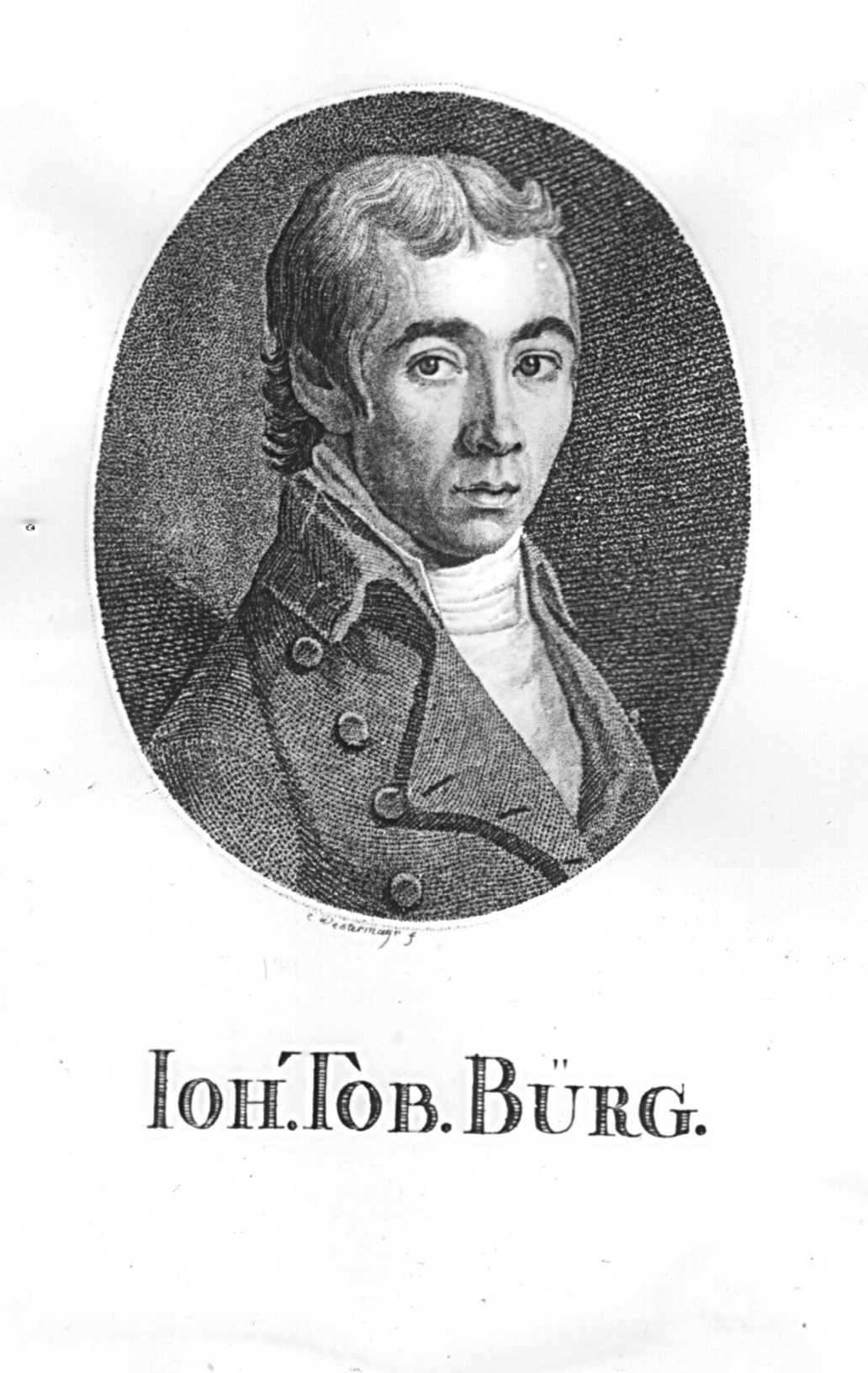Johann Tobias Bürg on:
[Wikipedia]
[Google]
[Amazon]
 Johann Tobias Bürg (December 24, 1766 – November 15, 1835), sometimes known as Johannes Burg,Plotner, Tammy
Johann Tobias Bürg (December 24, 1766 – November 15, 1835), sometimes known as Johannes Burg,Plotner, Tammy
''The Night Sky Companion: A Yearly Guide to Sky-Watching 2009'', p. 319.
Springer Science+Business Media (New York), 2009. was an
Aeiou: Johann Tobias Bürg
{{DEFAULTSORT:Burg, Johann Tobias 1766 births 1835 deaths Scientists from Vienna 19th-century Austrian astronomers Corresponding members of the Saint Petersburg Academy of Sciences Fellows of the American Academy of Arts and Sciences 18th-century Austrian astronomers
 Johann Tobias Bürg (December 24, 1766 – November 15, 1835), sometimes known as Johannes Burg,Plotner, Tammy
Johann Tobias Bürg (December 24, 1766 – November 15, 1835), sometimes known as Johannes Burg,Plotner, Tammy''The Night Sky Companion: A Yearly Guide to Sky-Watching 2009'', p. 319.
Springer Science+Business Media (New York), 2009. was an
Austria
Austria, , bar, Östareich officially the Republic of Austria, is a country in the southern part of Central Europe, lying in the Eastern Alps. It is a federation of nine states, one of which is the capital, Vienna, the most populous ...
n astronomer
An astronomer is a scientist in the field of astronomy who focuses their studies on a specific question or field outside the scope of Earth. They observe astronomical objects such as stars, planets, moons, comets and galaxies – in either ...
.
Life
Born inVienna
en, Viennese
, iso_code = AT-9
, registration_plate = W
, postal_code_type = Postal code
, postal_code =
, timezone = CET
, utc_offset = +1
, timezone_DST ...
, Bürg worked as astronomical assistant to Franz Xaver von Zach
Baron Franz Xaver von Zach (''Franz Xaver Freiherr von Zach''; 4 June 1754 – 2 September 1832) was a Hungarian astronomer born at Pest, Hungary (now Budapest in Hungary).
Biography
Zach studied physics at the Royal University of Pest, and s ...
at the Gotha Observatory
Gotha Observatory (''Seeberg Observatory'', ''Sternwarte Gotha'' or ''Seeberg-Sternwarte'') was a German astronomical observatory located on Seeberg hill near Gotha, Thuringia, Germany. Initially the observatory was dedicated to astrometry, geodet ...
. From 1791 he served as a professor of physics at the '' Gymnasium'' in Klagenfurt
Klagenfurt am WörtherseeLandesgesetzblatt 2008 vom 16. Jänner 2008, Stück 1, Nr. 1: ''Gesetz vom 25. Oktober 2007, mit dem die Kärntner Landesverfassung und das Klagenfurter Stadtrecht 1998 geändert werden.'/ref> (; ; sl, Celovec), usually ...
, Carinthia. He subsequently became assistant at the Vienna Observatory
The Vienna Observatory (german: Universitätssternwarte Wien) is an astronomical observatory in Vienna, Austria. It is part of the University of Vienna. The first observatory was built in 1753–1754 on the roof of one of the university buildings ...
, where in 1817 he succeeded as director after the death of Franz de Paula Triesnecker.
In 1799 he published astronomical tables on the Orbit of the Moon
The Moon orbits Earth in the prograde direction and completes one revolution relative to the Vernal Equinox and the stars in about 27.32 days (a tropical month and sidereal month) and one revolution relative to the Sun in about 29.53 days (a ...
based on about 3,000 observations, that were praised for their accuracy. For these astronomical tables, Bürg was made a member of the French Academy of Sciences. He also was elected a Foreign Honorary Member of the Russian Academy of Sciences
The Russian Academy of Sciences (RAS; russian: Росси́йская акаде́мия нау́к (РАН) ''Rossíyskaya akadémiya naúk'') consists of the national academy of Russia; a network of scientific research institutes from across ...
and the Hanoverian Göttingen Academy of Sciences and Humanities
The Göttingen Academy of Sciences (german: Akademie der Wissenschaften zu Göttingen)Note that the German ''Wissenschaft'' has a wider meaning than the English "Science", and includes Social sciences and Humanities. is the second oldest of the se ...
in 1801, of the Prussian Academy of Sciences
The Royal Prussian Academy of Sciences (german: Königlich-Preußische Akademie der Wissenschaften) was an academy established in Berlin, Germany on 11 July 1700, four years after the Prussian Academy of Arts, or "Arts Academy," to which "Berlin ...
in 1812, as well as of the American Academy of Arts and Sciences
The American Academy of Arts and Sciences (abbreviation: AAA&S) is one of the oldest learned societies in the United States. It was founded in 1780 during the American Revolution by John Adams, John Hancock, James Bowdoin, Andrew Oliver, a ...
in 1822.
He died at Wiesenau Castle, near Sankt Leonhard in Carinthia, where he is also buried. In 1834 the crater Bürg on the Moon was named by Johann Heinrich von Mädler
Johann Heinrich von Mädler (29 May 1794, Berlin – 14 March 1874, Hannover) was a German astronomer.
Life and work
His father was a master tailor and when 12 he studied at the Friedrich‐Werdersche Gymnasium in Berlin. He was orphaned at ag ...
in his honour.
Notes
# Adolf Drechsler in his ''Ill. Lexikon der Astronomie'' (Leipzig
Leipzig ( , ; Upper Saxon: ) is the most populous city in the German state of Saxony. Leipzig's population of 605,407 inhabitants (1.1 million in the larger urban zone) as of 2021 places the city as Germany's eighth most populous, as ...
, 1881) gives Trier
Trier ( , ; lb, Tréier ), formerly known in English as Trèves ( ;) and Triers (see also names in other languages), is a city on the banks of the Moselle in Germany. It lies in a valley between low vine-covered hills of red sandstone in the ...
as Bürg's place of birth and 1835 as the year of death. Some sources give November 15 as his date of birth, others November 25, 1834 is sometimes given as his date of death.
References
External links
Aeiou: Johann Tobias Bürg
{{DEFAULTSORT:Burg, Johann Tobias 1766 births 1835 deaths Scientists from Vienna 19th-century Austrian astronomers Corresponding members of the Saint Petersburg Academy of Sciences Fellows of the American Academy of Arts and Sciences 18th-century Austrian astronomers